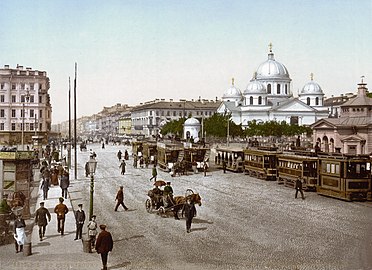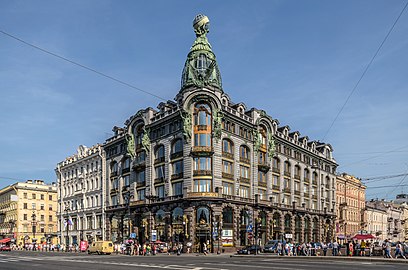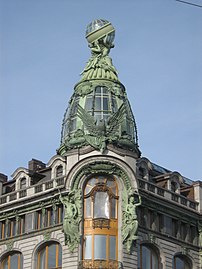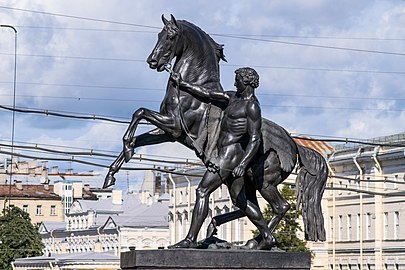Nevsky Prospect
|
Clockwise from top: Kazan Cathedral, Eliseyev Emporium, Grand Hotel Europe, Stroganov Palace, Anichkov Bridge, Singer House | |
| Native name | Не́вский проспе́кт (Russian) |
|---|---|
| Former name(s) | 25 October Prospect |
| Location | St. Petersburg |
| Coordinates | 59°55′54″N 30°21′10″E / 59.9318°N 30.3528°E |
Nevsky Prospect (Russian: Не́вский проспе́кт,
History of the street
18th century
Early 18th century. Reign of Peter the Great
On September 5, 1704,
In the early 1710s, a monastery (the future
It became necessary to connect the two city centers with the old Novgorodsky tract (which ran approximately along the route of the modern
Large promising road, Large perspective, Nevskaya perspective – the name of Nevsky prospect in those years ... starting from the Admiralty itself and continuing to the Alexandronevsky monastery, built ... in 1713
Andrew Ivanovich Bogdanov, Historical, geographical and topographic description of St. Petersburg from the beginning of its establishment, from 1703 to 1751. 10. Admiralty Island [4]
The first section of the highway from Moika to Fontanka was laid from 1710 to 1715, and then work continued on the section from Moika to the Admiralty.
One way or another, Nevsky Prospect emerged in the second half of the 1710s. The glades from the Admiralty and from the Lavra together formed the future Nevsky Prospect. It is precisely the fact that the two roads were laid independently of each other that explains the break in the highway in the area of modern Vosstaniya Square.[6]
The avenue immediately became a major highway in demand and, after building bridges over water obstacles, completely replaced the old path. The large perspective turned out to be about 4 miles long (4.5 kilometers), and 9 fathoms wide (about 20 meters).[1] A wooden drawbridge Green bridge across the Moika was erected in 1720.[7] The crossing was the city border in 1703–1726, taxes gathered here, for this there was Mytny Dvor, next to which was Gostiny Dvor.[2] Even earlier, a bridge was built across the Fontanka, in 1715 Emperor Peter I issued a decree: "Over the Big Neva on the Fountain River, there is a prospect to create a bridge." By May 1716,[7] the work was completed, and a wooden girder bridge on pile supports blocked both the channel itself and the swampy floodplain. In 1726 a guardhouse was erected and the city border was moved here.[2]
1725–1762. Nevsky Prospect in the Era of Palace coups
The great prospect became the main road: it was along it, as stated in the Senate decree of 1726, "there is always both arrival and departure of foreign and Russian subjects from everywhere to St. Petersburg." The government invested money in the improvement and cleanliness of the highway. In the 1720s, the initial section of the road running along
Translation in English of the quote: Description of this alley, made in 1721 by a chamber junker in the duke's retinue
At about six in the evening we arrived safely in St. Petersburg, which has changed so much since my departure from there that I did not recognize it at all. From the very beginning we entered a long and wide alley, (a small part of the road not far from the Admiralty), and justly called the avenue, because its end is almost invisible. It was laid only in a few years and exclusively by the hands of captured Swedes. Despite the fact that the trees planted on both sides of it in three or four rows are still small, it is unusually beautiful in its enormous length and the purity in which it is kept (captured Swedes must clean it every Saturday), and it makes a wonderful appearance , which I have not seen anywhere else. On the Admiralty, a beautiful and huge building at the end of this road, there is a beautiful and rather tall spitz, which goes directly opposite the avenue
Friedrich-Wilhelm von Berchholtz, Diary entry from 4 [O.S. 1721 ] July a [2][8]
By the end of the first quarter of the 18th century, the buildings of the Great Perspective were few. In the beginning, there were several small houses, on the right side at the corner of the Moika there was a Mytny Dvor, behind the Moika there were salt barns. On the site of the modern Gostiny Dvor, a birch grove was green, then there were "perevedenskie settlements" consisting of wooden houses. The vast territory on the left side of the road from Moika to Fontanka was owned by Empress Catherine I, was low, swampy and undeveloped. The suburb of St Petersburg began behind the Fontanka. On the right side were the houses of the Anichkov settlement, where the soldiers of the Admiralty Workers' Battalion lived under the command of Lieutenant Colonel M. O. Anichkov. This battalion in 1715 built a wooden bridge across the Fontanka, called Anichkov Bridge.
Behind this narrow access bridge, from 1726, there was a wooden guard house, documents were checked and the barrier was raised. A canal was laid along the route of the current Ligovsky Prospekt, which supplied water to the Summer Garden fountains. Further, the territory was covered with forest and almost not developed. Buildings appeared only closer to the monastery, where land was allotted "in a line along the promising road" for the workers and employees of the monastery.[1]
The construction of the avenue did not end there. In 1723, Peter I ordered to 'lay' the road from the cathedral church to the Admiralty in a prospective way. The road was supposed to abut against the vertical dominant –

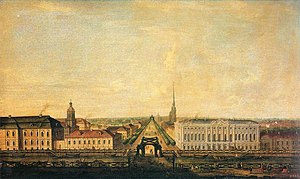
After a four-year stay in
All buildings on the shady side of the early 18th century were destroyed in the fire of 1736. Mytny Dvor caught fire, then the flame spread to the neighboring wooden buildings. The fire raged for several hours, and as a result, several quarters of philistine wooden houses near the Admiralty burned down. The second fire happened a year later, destroying most of the buildings in the center of St Petersburg. After that, according to the Commission on the St. Petersburg Building, wooden houses on Nevsky were no longer built.[9][10]
The Neva perspective became the most important factor that influenced the change in the layout of the entire settlement. She, together with
In the 1740s, the site at the corner with the Moika River was occupied by a two-story house
1799
The new
By the end of the 18th century, both sides of the highway beyond the Fontanka were almost built up. In the place where the metro station "Ploschad Vosstaniya" is now located, in 1765, according to the project of the architect
19th and early 20th centuries

Vasily Sadovnikov, watercolor, 1837
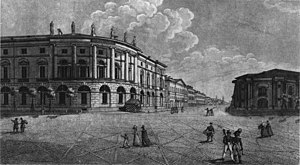
1800s
The final design of Nevsky Prospekt as an avenue-ensemble took shape in the first third of the 19th century. At this time, the masters of high classicism were creating. In 1799, a competition was announced for the construction of a cathedral on the site of the Church of the Nativity of the Virgin, which was won by the former serf of the Stroganov counts,
In 1806–23, the Admiralty was rebuilt. At the same time, work was underway to improve the surrounding areas. In 1816–1818, a boulevard into three alleys was laid out on the site of a moat and a rampart. At the same time, ensembles appeared, designed by architect Carlo Rossi. The ensemble
In the 1830s, artist Vasily Sadovnikov made a series of lithographs depicting both sides of Nevsky Prospekt from Admiralteyskaya Square to Anichkov Bridge, known as the "Panorama of Nevsky Prospekt" (1830–1835). Made in watercolors, almost 16 meters long, it was translated into lithographic stone and published by A. M. Prevost in a series of 30 sheets.[14]
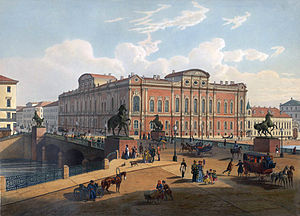
By order of Emperor Paul I in 1800, two boulevards were created along Nevsky Prospekt in the section from Moika to Fontanka. In 1802–1803 they were replaced by one boulevard of lindens, designed by the architect I. E. Stamov by garden masters F. Lyamin and M. Prokopin. The level of the boulevard became higher than the pavement; stepped slopes were added opposite bridges and cross streets. Two years later, the boulevard next to the Kazan Cathedral under construction was liquidated, and in 1819 it was completely abandoned in the middle of the avenue, replacing it with ordinary plantings of trees along the new granite sidewalks of the avenue. Landings were interrupted at the Catherine Canal and cross streets. The entire row planting existed until 1841, when by order of the emperor Nicholas I it was liquidated, all trees were transplanted into Summer Garden. Ordinary plantings were restored in 1897 on the sites in front of the Kazan Cathedral (liquidated two years later in connection with the construction of the square) and Gostiny Dvor.[3]
In 1832, the pavement on the avenue was replaced with a paved one
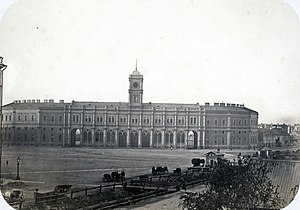
Photo 1860s
The only square of Nevsky Prospekt, formed during the period of capitalist development, is
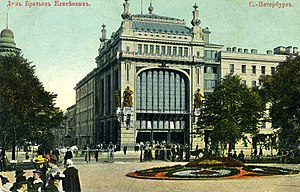
Postcard from the 1910s

By the beginning of the 20th century, modern had gained popularity. In this style in 1902–1904 was built
Nevsky Prospekt became the business and financial center of the city. As the city guidebooks describe the avenue, it has turned into a "life artery", "the center of splendor, luxury and grace of the capital". "Everything brilliant, precious, luxurious is combined here, which only St. Petersburg trade and industry can flaunt." The most famous and largest shopping center was Gostiny Dvor. By the end of the 19th century,
21st century. Modern period
In the 1990s, houses Nos. 15, 55, 59, 68, 114 and 116 were completely dismantled. New buildings were erected in their place with a partial or complete reconstruction of the historical façade. The buildings were deliberately brought to accidents by the owners or were recognized as such illegally, the dismantling of buildings was carried out without permits. The appearance of some in the early 2010s was distorted due to the construction of attics (houses no. 3, 64).[18]
From 1999 to 2004, a comprehensive reconstruction of Nevsky Prospekt from the Admiralty to Vosstaniya Square was underway: paving with granite slabs of sidewalks was carried out, communications and engineering networks were changed. In 2005–2006, the facades of almost all buildings were decorated with artistic lighting. In 2008, a lane for public transport was separated from the Admiralty to Vosstaniya Square. On the sidewalks from Vosstaniya Square to Alexander Nevsky Square, the asphalt pavement was replaced with a granite one [18]
Nevsky Prospect is a venue for mass celebrations. On
Nevsky Prospect, 19th century. Engravings
- Nevsky Prospect, XIX century. Engravings
-
View of Nevsky Prospect and Anichkov Bridge, 1753
-
Nevsky Prospect near Gostiny Dvor, 1799. Printmaking (engraving) by Benjamin Patersen.
-
"View of the Palace Square and the Winter Palace from the beginning of Nevsky Prospect", 1801. Engraving by Benjamin Patersen.
-
The avenue near the Nicholas Station, 1890s. Engraving by Benjamin Patersen.
-
The Fontanka River at the Anichkov Bridge. 19th or early 20th century
-
Panorama of Nevsky Prospect, 1830s. Engraving by Vasily Sadovnikov.
-
Anichkov Bridge and the Beloselsky-Belozersky Palace, 1850s. Engraving by Charlemagne.
History of the name
20th century
During the early Soviet years (1918–44) the name of Nevsky Prospect was changed, first and briefly to "Proletkult Street" (Ulitsa Proletkul'ta) in honor of that Soviet artistic organization.[21] Following the demise of Proletkult already around 1920 the name was changed again, this time to "Avenue of the 25th of October", alluding to the day of the October Revolution: the name never took on in the daily language of the city's inhabitants who continued to use the pre-revolutionary name. During the siege of Leningrad (1941–1944) some walls on the north side of Nevsky Prospect were stencilled with the inscription "Citizens! During shelling this side of the street is the most dangerous", warning passers-by of the areas most at risk from German artillery bombardment.[22] In 1962, the inscription was recreated on school building No. 210 on Nevsky Prospect through the initiative of poet Mikhail Dudin.[22][23] The inscription, and other examples across the city, are considered war memorials and are frequently the site of commemorations of the siege. In January 2019 Governor of Saint Petersburg Alexander Beglov laid flowers at the inscription on Nevsky Prospect.[24]
At the end of the siege of Leningrad, in January 1944, the name Nevsky Prospect was formally restored and has remained ever since.[25]
Significance
The Nevsky today functions as the main thoroughfare in Saint Petersburg. The majority of the city's shopping and nightlife takes place on or immediately off Nevsky Prospekt.
The street is served by the stations Admiralteyskaya, Nevsky Prospekt, Gostiny Dvor, Mayakovskaya, Ploshchad Vosstaniya and Ploshchad Alexandra Nevskogo I of Saint Petersburg Metro.[26]
Sightseeings of the Nevsky Prospekt

Major sights include the Rastrelliesque Stroganov Palace, the grand neoclassical Kazan Cathedral, the Art Nouveau Bookhouse (originally the Singer House), Elisseeff Emporium, half a dozen 18th-century churches, a monument to Catherine the Great, the Great Gostiny Dvor, the Passage, the Russian National Library, the Alexandrinsky Theatre, and the Anichkov Bridge with its horse statues. Nevsky Prospekt is a part of UNESCO World Heritage list.[27]
- Singer House
-
Frontal view of the Singer House, located at the Nevsky prospect
-
The tower with the globe on the top
-
Sculptures on the facade
- Anichkov Bridge
-
Peter Klodt von Jurgensburg. The silhouettes of the sculptural groups on high pedestals are so expressive that they ensured incredible success for this monument.
-
Peter Klodt von Jurgensburg. The silhouettes of the sculptural groups on high pedestals are so expressive that they ensured incredible success for this monument.
Nevsky prospect in the Russian classic literature of the 19th century
Nikolai Gogol described the feverish life of the avenue in his story "Nevsky Prospekt", published in 1835. Fyodor Dostoevsky often employed Nevsky Prospekt as a setting in his works, such as Crime and Punishment (1866) and The Double: A Petersburg Poem (1846). The café-restaurant which the famous writers of the 19th-century Golden Age of the Russian literature frequented still remains as "Literary Cafe" on Nevsky Prospect.
Нет ничего лучше Невского проспекта, по крайней мере в Петербурге; для него он составляет всё. Чем не блестит эта улица — красавица нашей столицы! Я знаю, что ни один из бледных и чиновных её жителей не променяет на все блага Невского проспекта. Не только кто имеет двадцать пять лет от роду, прекрасные усы и удивительно сшитый сюртук, но даже тот, у кого на подбородке выскакивают белые волоса и голова гладка, как серебряное блюдо, и тот в восторге от Невского проспекта. А дамы! О, дамам ещё больше приятен Невский проспект. Да и кому же он не приятен? Едва только взойдешь на Невский проспект, как уже пахнет одним гуляньем. Хотя бы имел какое-нибудь нужное, необходимое дело, но, взошедши на него, верно, позабудешь о всяком деле. Здесь единственное место, где показываются люди не по необходимости, куда не загнала их надобность и меркантильный интерес, объемлющий весь Петербург. |
There is nothing better than Nevsky Prospect, at least in St. Petersburg; for the city, it is everything. How it shines– the beauty of our capital! I know that none of its pale and bureaucratic residents would exchange Nevsky Prospekt for any number of riches. Not only he who is twenty-five years old, with a wonderful mustache and an astonishingly tailored frock coat, but even someone with white hair popping out on their chin and a head as smooth as a silver dish is delighted with Nevsky Prospect. And the ladies! Oh, the ladies are even more pleased with Nevsky Prospect. And who doesn't like it? As soon as you climb onto Nevsky Prospekt, it already smells of promenades. One may have some necessary, indispensable business, but, having walked on to Nevsky Prospekt, you will surely forget about any sort of business at all. Here is the only place where people don't go out of necessity, where their needs and mercantile interest, which embraces the whole of Petersburg, has not driven them. |
| —Excerpt from Nikolai Gogol's 1835 short story "Nevsky Prospekt". |
See also
- List of upscale shopping districts
Footnotes
- ^ a b c d Chesnokova AN (1985). Nevsky Prospect. Leningrad: Lenizdat. pp. 5–14.
- ^ a b c d e f g h i "Парадный въезд в новую страницу". Невский Проспект [Nevsky Prospect]. 1985.
- ^ a b c d e f g h Vesnina N.N. (2008). Nevsky Prospect Gardens. SPb.: Propylaea. pp. 10–18.
- ^ А. И. Богданов (1997). "Предисловие". Описание Санктпетербурга. Санкт-Петербург: Северо-Западная Библейская Комиссия. Санкт-Петербургский филиал Архива Российской Академии наук.
- ^ P.N. Stolpyanskiy (1918). How it appeared, was founded and grew St. Petersburg. SPb. p. 319.
{{cite book}}: CS1 maint: location missing publisher (link) - ^ "Невский проспект на официальном портале Администрации Санкт-Петербурга". Archived from the original on 2 September 2007. Retrieved 27 August 2007.
- ^ a b Bunin M.S. Bridges of Leningrad.
- Наука и жизньed.). Moscow.
- ^ "Самая знатная улица". Невский Проспект [Nevsky Prospect]. 1985.
- ^ a b c d e Chesnokova AN (1985). Nevsky Prospect. L.: Lenizdat. pp. 14–31.
- ^ T.F.Savarenskaya (2004). History of urban planning art. Late feudalism and capitalism (Architecture-C ed.). M. pp. 109–113.
{{cite book}}: CS1 maint: location missing publisher (link) - ^ a b c Chesnokova AN (1985). Nevsky Prospekt. L.: Lenizdat. pp. 31–44.
- ^ Leningrad. Guide. Compiled by Serpokryl S. M. L.: Lenizdat. 1973. pp. 133–140.
{{cite book}}: CS1 maint: others (link) - ^ IG Kotelnikova (1971). Panorama of Nevsky Prospekt VS Sadovnikov. YM Denisov. Supplement to the album "Panorama of Nevsky Prospekt by V.S. Sadovnikov". L.: Aurora.
- ^ a b c d e f Chesnokova AN (1985). Nevsky Prospekt. L.: Lenizdat. pp. 46–64.
- ^ St. Petersburg: Encyclopedia. Moscow: Russian Political Encyclopedia. 2006. pp. 9, 882.
- ^ Editor-compiler Dmitry Sherikh (1995). Book of Records Petersburg. All the most in the history and life of the city. St. Petersburg: Ivanov and Leshchinsky. pp. 183–187.
{{cite book}}:|author=has generic name (help) - ^ a b "Невский проспект — история: от создания до современности". Retrieved 9 September 2019.
- ^ "Nevsky Prospekt – history and photos". Walking in St. Petersburg – an author's project about the history and sights of St. Petersburg. Retrieved 30 December 2019.
- ^ "Religious procession on Nevsky Prospekt September 12, 2018: street block diagram". Komsomolskaya Pravda in St. Petersburg. Retrieved 30 December 2019.
- ^ Lynn Mally, Culture of the Future: The Proletkult Movement in Revolutionary Russia. Berkeley, CA: University of California Press, 1990; pg. 44.
- ^ a b Bratskiy, Yan (19 November 2018). "В Петербурге вандалы закрасили историческую надпись "При артобстреле эта сторона улицы наиболее опасна"" (in Russian). Zvezda. Retrieved 1 May 2019.
- ISBN 9785459003901.
- ^ "Александр Беглов возложил цветы к памятной надписи на Невском проспекте" (in Russian). 5-Родной. 26 January 2019. Retrieved 1 May 2019.
- ^ "Невский проспект.Санкт-Петербург".
- ^ Nevsky Prospekt – "The Prospekt has five Metro stations along its length, with each having its own unique identity. These are; "Ploshchad Aleksandra Nevskogo", "Ploshchad Vosstaniya", "Mayakovskaya", "Gostinyy Dvor" and "Nevsky Prospekt". A sixth station called 'Admiralty' has just been built on the M5 line just off Nevsky on Bolshaya Morskaya ul."
- ^ "Historic Centre of Saint Petersburg and Related Groups of Monuments". UNESCO World Heritage Centre. Retrieved 4 December 2020.
External links
 Media related to Nevsky Prospekt at Wikimedia Commons
Media related to Nevsky Prospekt at Wikimedia Commons











